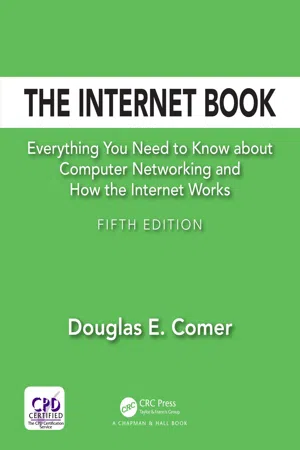
The Internet Book
Everything You Need to Know about Computer Networking and How the Internet Works
- 376 pages
- English
- ePUB (mobile friendly)
- Available on iOS & Android
The Internet Book
Everything You Need to Know about Computer Networking and How the Internet Works
About this book
The Internet Book, Fifth Edition explains how computers communicate, what the Internet is, how the Internet works, and what services the Internet offers. It is designed for readers who do not have a strong technical background — early chapters clearly explain the terminology and concepts needed to understand all the services. It helps the reader to understand the technology behind the Internet, appreciate how the Internet can be used, and discover why people find it so exciting. In addition, it explains the origins of the Internet and shows the reader how rapidly it has grown. It also provides information on how to avoid scams and exaggerated marketing claims.
The first section of the book introduces communication system concepts and terminology. The second section reviews the history of the Internet and its incredible growth. It documents the rate at which the digital revolution occurred, and provides background that will help readers appreciate the significance of the underlying design. The third section describes basic Internet technology and capabilities. It examines how Internet hardware is organized and how software provides communication. This section provides the foundation for later chapters, and will help readers ask good questions and make better decisions when salespeople offer Internet products and services. The final section describes application services currently available on the Internet. For each service, the book explains both what the service offers and how the service works.
About the Author
Dr. Douglas Comer is a Distinguished Professor at Purdue University in the departments of Computer Science and Electrical and Computer Engineering. He has created and enjoys teaching undergraduate and graduate courses on computer networks and Internets, operating systems, computer architecture, and computer software. One of the researchers who contributed to the Internet as it was being formed in the late 1970s and 1980s, he has served as a member of the Internet Architecture Board, the group responsible for guiding the Internet's development. Prof. Comer is an internationally recognized expert on computer networking, the TCP/IP protocols, and the Internet, who presents lectures to a wide range of audiences. In addition to research articles, he has written a series of textbooks that describe the technical details of the Internet. Prof. Comer's books have been translated into many languages, and are used in industry as well as computer science, engineering, and business departments around the world. Prof. Comer joined the Internet project in the late 1970s, and has had a high-speed Internet connection to his home since 1981. He wrote this book as a response to everyone who has asked him for an explanation of the Internet that is both technically correct and easily understood by anyone. An Internet enthusiast, Comer displays INTRNET on the license plate of his car.
Frequently asked questions
- Essential is ideal for learners and professionals who enjoy exploring a wide range of subjects. Access the Essential Library with 800,000+ trusted titles and best-sellers across business, personal growth, and the humanities. Includes unlimited reading time and Standard Read Aloud voice.
- Complete: Perfect for advanced learners and researchers needing full, unrestricted access. Unlock 1.4M+ books across hundreds of subjects, including academic and specialized titles. The Complete Plan also includes advanced features like Premium Read Aloud and Research Assistant.
Please note we cannot support devices running on iOS 13 and Android 7 or earlier. Learn more about using the app.
Information
Contents
Table of contents
- Cover
- Halftitle Page
- Title Page
- Copyright
- Table of Contents